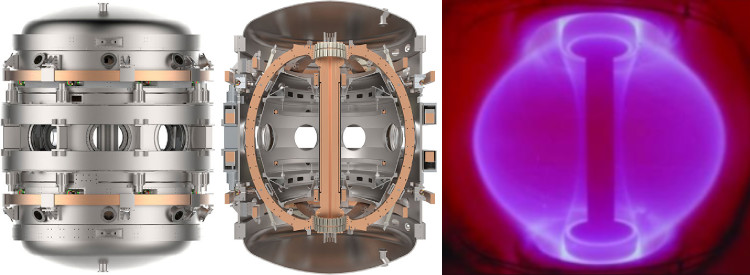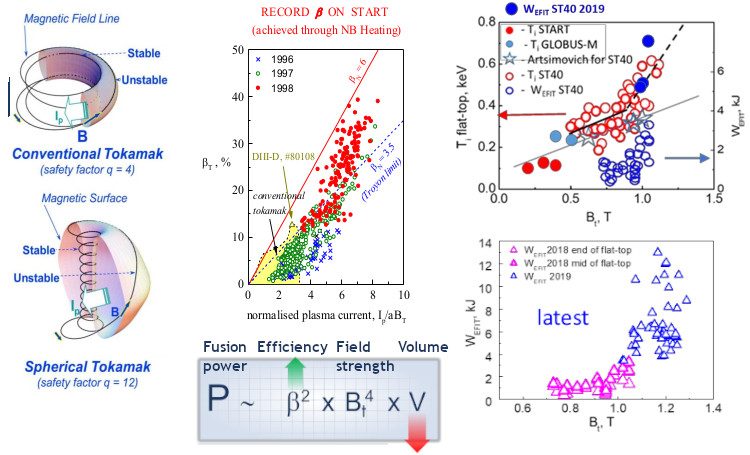
On September 14th, our Fusion Group had the pleasure to organize the second FusionCAT webinar together with BSC as the FusionCAT project coordinator.
The webinar given by Dr Mikhail Gryaznevich, Chief Scientist at Tokamak Energy Ltd was entitled Faster Fusion through Innovations and it was attended by 53 participants from diverse nationalities and backgrounds. The discussion delved into the increasingly significant role of private funded fusion research and the particular scientific innovations of Tokamak Energy.
Public funded fusion projects such as ITER or DEMO are typically very long-term and large-scale due to the need of demonstrating the viability of a whole functioning nuclear reactor. In these projects early design decisions must often be taken and they cannot be easily modified during the long duration of the project.
The Fusion Industry Association gathers several companies that develop smaller-scale innovations exploiting their higher flexibility, faster decision process and capacity to assume risks. For instance, Tokamak Energy focuses on three main innovations being spherical tokamaks, high temperature superconductor (HTS) magnets and magnetic re-connection. Ideally, collaboration between public and private stakeholders will enhance the capabilities of all future projects.
Regarding the spherical tokamak development at Tokamak Energy, five devices have been already produced and tested since 2012. They have proven an increase in the ratio between the plasma pressure to magnetic pressure (usually defined as beta β) which still has a much larger potential. This leads to a reduction in plasma volume (and hence the reactor size) for a fixed field strength and fusion power. With smaller reactors it is possible to pursue modular power plants that can be constructed by phases. In addition to the lower initial partial investment required, serial production and the possibility of shutting down one of the modules diminish construction and long term maintenance costs.

HTS materials have increased mechanical, thermal and conductive properties that can be exploited to improve fusion reactors. Besides being the only available solution allowing more than 20T on the conductors, it allows a reduction of cryo-power needed for compact reactors. The higher resistance to quenching, neutron radiation and mechanical failure delay the need for replacements. Furthermore, the latter solves the increase of stresses derived from the higher beta obtained with spherical tokamaks.

Finally, the theory of magnetic re-connection was developed in astrophysics in the 1960’s to 1970’s. First results from the ST40 tokamak confirm that in addition to use the magnetic field for the containment of the plasma, it is possible to transfer magnetic energy directly into the plasma thermal energy (heating it) with up to a 90% efficiency. According to re-connection heating theory and the experimental data collected from START, MAST and Japanese devices, the plasma in ST40 should show burning conditions (nT) with temperatures around 10 keV.
The webinar was opened by our group leader ICREA Prof. Mervi Mantsinen who gave a short introduction to the objectives of the FusionCAT project. The event was chaired by Grisha Domakowski who is the Head of Projects at b_TEC. The question and answer (Q&A) session started with a the discussion about HTC durability and how it is more difficult to detect quench in HTS magnets but at the same time it does not constitute a big threat due to the resilience of HTS magnets. The configuration of HTS, its loading constrains and what limitations impart on the size of forthcoming Tokamaks was also enquired.
Other active topics of discussion included the production of tritium on spherical tokamaks, the possibilities of breeding blanket designs and the expected timescale for achieving self-sustained fusion production in a spherical tokamak. The advantages and change of constrains of spherical tokamaks with respect to conventional tokamaks together with the type of materials and its requirements for several parts of the reactors completed the technical part of the Q&A session. Finally, a more practical part of the Q&A session included putting in common the funding challenges and constrains of fusion private sector, the simulation tools employed and the collaborations that Tokamak Energy has already established with various stakeholders.
Sources: webinar slides, Tokamak Energy.
The webinar is organized under the auspices of the FusionCAT project with reference number 001-P-001722 that has been co-financed by the European Union Regional Development Fund within the framework of the ERDF Operational Program of Catalonia 2014-2020, with the support of Generalitat of Catalonia.
